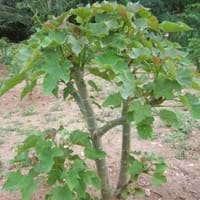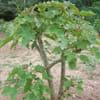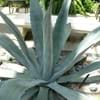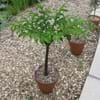Life Span
Perennial
Perennial
Origin
Caribbean, Central America, South America, Madagascar, South Africa
Africa, South-Eastern Asia
Types
Jatropha bullockii, Jatropha cinerea, Jatropha excisa
Not Available
Number of Varieties
Not Available
Habitat
Pastures, Roadsides, Warmer regions
Subtropical forests, Tropical regions
USDA Hardiness Zone
Not Available
5-9
AHS Heat Zone
Not Available
9 - 5
Sunset Zone
Not Available
1a, 1b, 2a, 2b, 3a, 3b, 7, 8, 9, 10, 11, 14, 18, 19, 20, 21
Habit
Upright/Erect
Clump-Forming
Flower Color
White, Yellow, Red, Purple, Pink
Pale Yellow, Yellow green
Flower Color Modifier
Not Available
Bicolor
Fruit Color
Light Green, Lime Green, Yellow, Green, Ivory
Green, Light Green
Leaf Color in Spring
Green, Dark Green
Green
Leaf Color in Summer
Green, Dark Green
Light Green
Leaf Color in Fall
Green, Dark Green
Green, Light Green
Leaf Color in Winter
Green, Dark Green
Brown, Light Yellow, Tan
Leaf Shape
Palmately Lobed
Oval
Plant Season
All year
Summer, Fall, Winter
Sunlight
Bright direct sunlight, Full Sun, Partial Sun
Full Sun
Growth Rate
Medium
Medium
Type of Soil
Dry, Sand
Clay, Loam, Sand
The pH of Soil
Slightly Alkaline
Acidic, Neutral, Alkaline
Soil Drainage
Well drained
Average
Bloom Time
All year
Summer, Late Summer, Early Fall
Tolerances
Drought
Pollution, Drought, Salt
Where to Plant?
Ground
Ground
How to Plant?
Seedlings, Transplanting
Seedlings, Stem Cutting
Plant Maintenance
Low
Medium
Watering Requirements
Needs less watering, Water occasionally
Needs less watering
In Summer
Drought Tolerant, Average Water
Lots of watering
In Spring
Less Watering
Moderate
In Winter
Less Watering
Average Water
Soil pH
Neutral
Acidic, Neutral, Alkaline
Soil Type
Loam, Sand
Clay, Loam, Sand
Soil Drainage Capacity
Well drained
Average
Sun Exposure
Bright direct sunlight, Full Sun
Full Sun
Pruning
Prune for shortening long shoots, Prune if you want to improve plant shape
A hard prune may be necessary if the plant becomes woody, Cut upper 1/3 section when young to enhancegrowth, Remove damaged leaves, Remove dead branches, Remove dead leaves
Fertilizers
All-Purpose Liquid Fertilizer, No fertilizers needed
10-10-10 diluted liquid fertilizer, All-Purpose Liquid Fertilizer, Compost
Pests and Diseases
Anthracnose, Leaf spot, Powdery mildew, Red blotch, Rust
Aphids, Downy mildew, Purple Blotch, Red blotch
Plant Tolerance
Drought, Drought and Salt, Heat Tolerance
Drought, Salt and Soil Compaction, Shade areas
Flower Petal Number
Single
Single
Foliage Texture
Bold
Fine
Foliage Sheen
Not Available
Glossy
Invasive
Sometimes
Sometimes
Attracts
Bees, Flying insects, Hoverflies
Bees, Flies, pollinators
Allergy
allergic conjunctivitis, Eye irritation
conjunctivitis, sneezing
Aesthetic Uses
Not Available, Not Used For Aesthetic Purpose
Not Used For Aesthetic Purpose
Beauty Benefits
Good for skin and hair, Removes pimples, Skin inflammation, Skin irritation
Making cosmetics, Not Available
Edible Uses
Sometimes
Yes
Environmental Uses
Air purification, Insect Repellent, No fertilizer, pesticides, or herbicides needed, Suppresses or replaces native plants, Versatility
Air purification, Shadow Tree, Soil protection
Medicinal Uses
anti-allergy, epilepsy, Fever, Skin irritation, Skin Redness
Cardiovascular problems, Detoxifies lever, Diabetes, Dysentry, Jaundice, Menstrual Disorders
Part of Plant Used
Leaves, Sap, Seeds, Stem
Inner Bark, Leaf Stalks
Other Uses
Oil is used as fuel, Oil is used in perfume, soaps, creams, etc., Used in biomass
Can be made into a herbal tea, Oil is used for aromatherapy, Used as a fodder tree in agricultural areas
Used As Indoor Plant
No
No
Used As Outdoor Plant
Yes
Yes
Garden Design
Container, Feature Plant, Hedges, Screening, Wind Break, Topiary, Bonsai, Espalier, Tropical
Dried Flower/Everlasting, Lawns and Turf, Mixed Border, Wildflower
Botanical Name
JATROPHA
Terminalia arjuna
Common Name
Barbados nut, purging nut, physic nut, or JCL
Arjuna
In Hindi
रतनजोत
अर्जुन वृक्ष
In German
Purgiernuß
Terminalia arjuna
In French
purghère
Terminalia arjuna
In Spanish
frailejón
Migdałecznik arjuna
In Portuguese
galamaluco
Migdałecznik arjuna
In Polish
jatrofa
Migdałecznik arjuna
Phylum
Magnoliophyta
Magnoliophyta
Class
Magnoliopsida
Not Available
Order
Euphorbiales
Myrtales
Family
Euphorbiaceae
Poaceae
Genus
Jatropha
Terminilia
Clade
Dicotyledonous
Angiosperms, Eudicots, Rosids
Tribe
Jatropheae
Not Available
Subfamily
Crotonoideae
Not Available
Importance of Jatropha and Arjuna Tree
Want to have the most appropriate plant for your garden? You might want to know the importance of Jatropha and Arjuna Tree. Basically, these two plants vary in many aspects. Compare Jatropha and Arjuna Tree as they differ in many characteristics such as their life, care, benefits, facts, etc. Every gardener must at least have the slightest clue about the plants he wants to plant in his garden. Compare their benefits, which differ in many ways like facts and uses. The medicinal use of Jatropha is anti-allergy, epilepsy, Fever, Skin irritation and Skin Redness whereas of Arjuna Tree is Cardiovascular problems, Detoxifies lever, Diabetes, Dysentry, Jaundice and Menstrual Disorders. Jatropha has beauty benefits as follows: Good for skin and hair, Removes pimples, Skin inflammation and Skin irritation while Arjuna Tree has beauty benefits as follows: Good for skin and hair, Removes pimples, Skin inflammation and Skin irritation.
Compare Facts of Jatropha vs Arjuna Tree
How to choose the best garden plant for your garden depending upon its facts? Here garden plant comparison will help you to solve this query. Compare the facts of Jatropha vs Arjuna Tree and know which one to choose. As garden plants have benefits and other uses, allergy is also a major drawback of plants for some people. Allergic reactions of Jatropha are allergic conjunctivitis and Eye irritation whereas of Arjuna Tree have conjunctivitis and sneezing respectively. Having a fruit bearing plant in your garden can be a plus point of your garden. Jatropha has showy fruits and Arjuna Tree has showy fruits. Also Jatropha is not flowering and Arjuna Tree is not flowering . You can compare Jatropha and Arjuna Tree facts and facts of other plants too.





